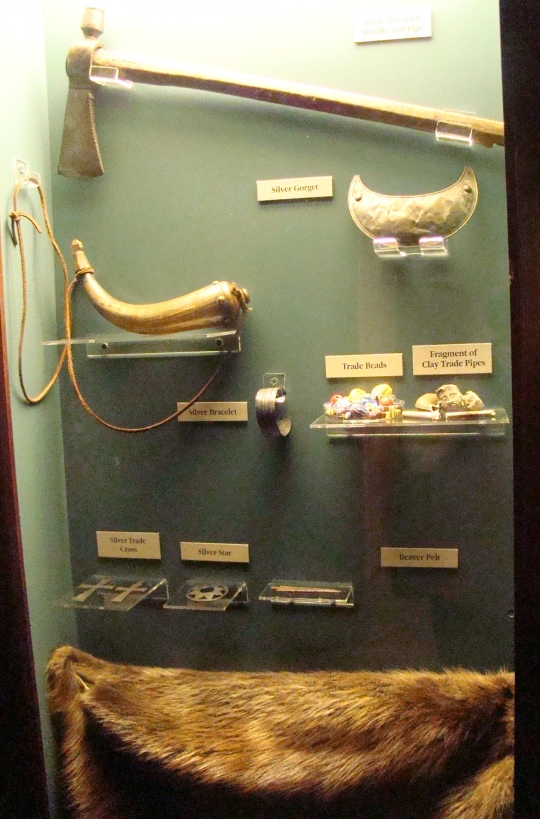Delaware Indians Settle Schoenbrunn Village
 Step back in time nearly two hundred and fifty years to see the location of the first church and school west of the Allegheny Mountains. Along the banks of the Tuscarawas River in New Philadelphia experience historic Schoenbrunn Village.
Step back in time nearly two hundred and fifty years to see the location of the first church and school west of the Allegheny Mountains. Along the banks of the Tuscarawas River in New Philadelphia experience historic Schoenbrunn Village.

Scouts from Pennsylvania came to see if this would be a great place to settle.
A group of Christian Delaware Indians arrived from Pennsylvania with Moravian missionary, David Zeisberger, in 1772. They came by invitation of Chief Netawatwes, head of the Turtle Tribe in the Tuscarawas Valley of Ohio.

This portrait of David Zeisberger hangs in their museum.
David was born in Moravia, which is now part of the Czech Republic. His parents immigrated to Georgia to become missionaries. They sent David to school in Holland, but harsh conditions there caused him to flee to the United States to join his parents.
The family moved to Pennsylvania, where David began preparing for his calling as a missionary to the Indians. He studied their language and learned the traditions of the tribe. Often considered a genius, many called Zeisberger the Apostle of the Indians.

A guide welcomed visitors as he strolled through the reconstructed village.
Near a big spring, deep in the woods, a settlement was established called ‘Beautiful Spring’ by the Delaware Indians, but translated into ‘Schoenbrunn’ by the Germans. This provided a safe place for the Delaware Indians who had converted to the Moravian faith. Religious services were an important part of each day.

These young men both had Indian blood – one Iroquois and the other Delaware. The glass beads they wore served as early travelers’ checks.
From 1772-1777, this village housed approximately 300 people. The only white people there were Zeisberger, his assistant missionary and the missionary’s wife. The remainder of the village consisted of Christian Delaware Indians.
The village had a short five-year existence due to pressure from both Delaware Indians, and frontiersmen wanting to settle in Ohio. Originally the village contained about forty buildings, but over time these buildings were destroyed, the land was farmed, and all traces removed of the settlement.
The people of Tuscarawas County wished to commemorate this development. Maps, letters and the original diaries of Zeisberger led them to the general area where the town existed. After extensive research and archaeological excavations, the sites of the school and church were discovered and rebuilding of Schoenbrunn began in 1927.

Museum exhibits display tools used during the early days of Schoenbrunn.
At the entrance stands a museum filled with historic exhibits and an excellent video explaining the history of Zeisberger and the founding of Schoenbrunn Village. Here you will find tools the Delaware Indians used, the original school bell, and books written by Zeisberger. These included a translation of the Four Gospels into Delaware Indian language.

An herb garden provided their medicine. Most had confidence in the medicine man’s healing.
Today, Schoenbrunn contains seventeen reconstructed buildings, including the church and the school on their original sites. The location of the cemetery has also been discovered, while the stones were created in the 1920s. The Moravians had used identical wooden crosses on all graves because they felt all were equal in death.

Two Moravian women had the heavy task of making candles by dipping them fifty or sixty times.
The candlemakers in the Davis cabin actually still make all the candles used throughout the village. They were made of pure beeswax in those early days, to signify the purity of Christ. The Davis cabin served as home to a Native American, his wife and four children. The walls in many of the cabins were whitewashed in order to reflect the candle light.

Costumed volunteers meandered in front of the school where both boys and girls were educated.
Their schoolhouse sat in the center of the village where both boys and girls received instruction in their native Delaware language. Two doors entered the building – one for the girls to use, and one for the boys. In 1775, there were approximately one hundred children being educated.

Children enjoyed watching a wood-maker finish a leg for a bench. He also served as the interpreter for the village.
Anton cabin served as home to the village interpreter, making it easier for the whites and various Indian tribes to communicate with each other. This Delaware Indian also was talented in woodworking, making benches and repairing spinning wheels and wooden door hinges. Building a cabin took twenty-three days.
Everything in their community from school and church to their burial in God’s Acre was divided into what they called “choirs”. The young men and boys were placed together, the young women and girls, and then older men and older women. They did not congregate as families or get buried as such.

The missionary’s wife cooked meals here for her husband and David Zeisberger, a bachelor.
Authentically dressed volunteers, who all have a passion for history, help you understand what life was like in the 18th century. They serve as storytellers to explain the daily life of the early residents as well as the importance of missions in American history.

Churning butter took much time and patience.
Visit this historic Schoenbrunn Village Monday through Sunday from Memorial Day to the end of August. During September and October, they are only open on Saturday and Sunday. It’s a great place for a family excursion, where you can have an enjoyable outdoor adventure while learning about the history of early America.
Schoenbrunn Village is located in Tuscarawas County at 1984 E. High Street, New Philadelphia, Ohio. From I-77, take Exit 81 East on US 250. Next take Ohio Exit 259 to E High Street. The village will be on the left.